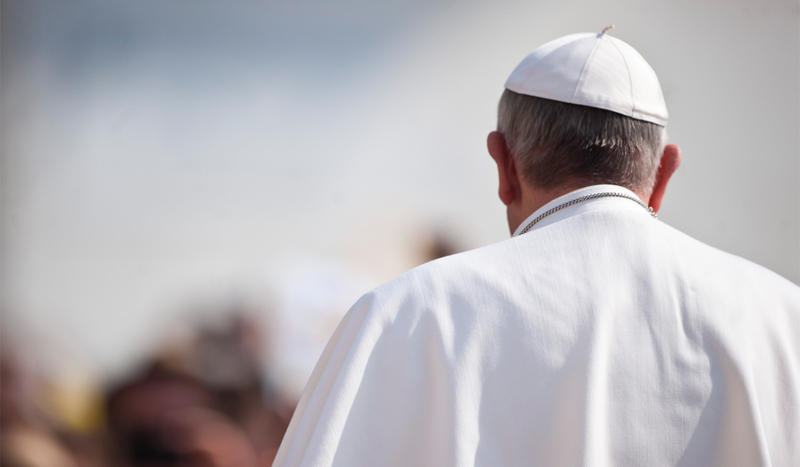
Catholic Church England and Wales / Flickr
CV NEWS FEED // A Pope Francis biographer stated online this week that the late pontiff never — to the biographer’s knowledge — promoted the art of disgraced former Jesuit Father Marko Rupnik, prompting a Connecticut-based priest to respond with a list of instances that he said suggest otherwise.
“How can Francis’s official biographer not know such basic facts?” wrote Holy Apostles College and Seminary professor Fr. Matthew Schneider, L.C., on X. “Francis has repeatedly promoted Rupnik art.”
He later added that Pope Francis did not “promote” Fr. Rupnik’s art in the sense that he directly told people to “‘buy prints of Rupnik,’ but his actions (& inactions) clearly promote Rupnik’s art after the crimes were known.”
Fr. Schneider cited one instance from 2015, as well as one from 2022, one from 2023, one from 2024, and 2025.
A 2024 video broadcast on a TV channel showed that Pope Francis had Fr. Rupnik art in his apartment. A 2025 photograph of Pope Francis in his apartment, standing in front of Fr. Rupnik art. Fr. Schneider noted that Pope Francis also retained a Vatican communications director who often posted Fr. Rupnik’s art on the Vatican website.
The online exchange between biographer Austen Ivereigh and Fr. Schneider occurred due to an initial online post, from someone else, related to the history of disgraced former Jesuit Father Marko Rupnik’s art, which has controversially remained featured at major shrines around the world even though he has been accused numeous times of sexual abuse. These accusations are currently under investigation.
The topic on X was initially brought up by EWTN Managing Editor Raymond Arroyo, who argued that “[t]he support (and protection) [that Fr. Rupnik] enjoyed by Pope Francis gave him access to some of the biggest shrines and churches in the world.” Arroyo expressed hope that with the election of a new pope, the “artist reign” held by Fr. Rupnik would come to an end.
Jesuit priest Father Jeremy Zipple responded to the post by stating that most of the major pieces created by Fr. Rupnik were made before Pope Francis’ pontificate. He noted that one in a chapel in the Apostolic Palace was commissioned in 1999 as a gift to then-Pope John Paul II by then-Cardinal Joseph Ratzinger and the College of Cardinals.
Responding to Fr. Zipple’s post, Ivereigh wrote: “Not only was JP2 the great promoter of Rupnik, but Francis was the first and only pope who lifted the statute of limitations to ensure he could be canonically tried and sanctioned.”
Here, Fr. Schneider replied to Ivereigh: “As far as any reports I’ve heard of, none of Rupnik’s crimes were known by John Paul II. Francis knew of his crimes & still chose to promote his art. There’s a big difference promoting Rupnik’s art before & his crimes were known.”
Fr. Rupnik was formally excommunicated in 2020 after being “found guilty of violating the confessional by absolving an Italian novice with whom he had engaged in sexual activity,” according to a February 2023 report by the National Catholic Register. The then-Congregation for the Doctrine of the Faith (CDF, now the Dicastery for the Doctrine of the Faith) ultimately determined the guilty verdict.
The excommunication was reportedly lifted a few weeks later. The Register’s report included an interview with canon lawyer Marc Balestrieri, who weighed in on questions surrounding Fr. Rupnik’s excommunication being lifted.
In his exchange with Fr. Schneider about the art, Ivereigh wrote, “Francis never, to my knowledge, promoted Rupnik’s art; John Paul II did. When the crimes became known, and the victims finally gave their testimony, Francis acted to enable Rupnik to be sanctioned.”
This was the post that Fr. Schneider responded to with the list of instances to the contrary. He argued at the end of the post that if one likes “X or Y” before knowing about abuse, but then learns of the abuse, there should be a change in one’s attitude toward it.
“Knowledge of hidden crimes should radically change your outlook,” he wrote.
It should be noted that it was never confirmed that Pope Francis lifted Fr. Rupnik’s excommunication, although he may have granted the absolution. In the interview with the National Catholic Register, Balestrieri had explained that the then-CDF was authorized to lift excommunications and did not require the Pope’s direct involvement.
However, “Pope Francis at least knew about the matter,” Balestrieri said, citing a January 2023 interview Pope Francis had with the Associated Press.
“One aspect that is little noted,” Balestrieri continued, “is the fact that the Holy Father usually meets every week with the prefect for the Dicastery for the Doctrine of the Faith and other superiors of the dicastery upon need.”
“It is inconceivable that Pope Francis was not informed by the prefect, Cardinal Ladaria Ferrer, of the status of the conviction of Father Rupnik,” Balestrieri explained, “or his petition to be absolved from his excommunication, unless Father Rupnik had succeeded in bypassing the congregation and obtaining directly from Francis absolution from his declared excommunication.”
CatholicVote previously reported that Pope Francis’ approach to handling clerical sexual abuse caused confusion and distrust during his pontificate.
“While [Pope Francis] took a strong stance against clerical sexual abuse,” the report stated, “his inconsistent approach in dealing with accusations against certain bishops and clergy led to accusations of selective enforcement. His dealings with figures such as former U.S. Cardinal Theodore McCarrick, Argentinian Bishop Gustavo Zanchetta, or Fr. Marko Rupnik left many questioning whether his promised reforms in this area were fully realized.”
